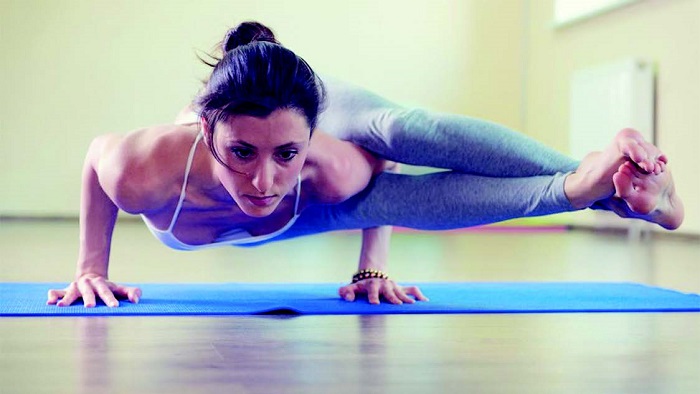
HIGH levels of stress has become a major issue in Ghana and the world at large. The science suggests that people battling stress can benefit from Yoga. This has been supported by Shohani et al., (2018) which found that Yoga, especially asana, is excellent in reducing stress. Apart from the physical aspect, meditation, breath work, and auditory rituals, like chanting and sound baths, have all also been shown to significantly lessen tension and relieve stress (Goldsby et al.,2017).
Movement-based Yoga therapies and breathing-based practices were found to significantly improve depressive symptoms.
Bridges & Sharma (2017) meta-analysis of 23 interventions looking at the effects of Yoga-based treatments on depressive symptoms overwhelmingly concluded that Yoga can now be considered an effective alternative treatment for MDD. Major depressive disorder (MDD) is one of the most common mental health disorders in the world. Another study by Streeter et al., (2017) also revealed that both movement-based Yoga therapies and breathing-based practices were found to significantly improve depressive symptoms.
Studies demonstrate linkage between Yoga and cardiovascular health
According to Pahwa et al., (2021), there is a link between cardiovascular disease, diabetes and other chronic diseases to chronic inflammation. However, the good news is that, one review which examined 15 studies by Djalilova et al., (2018) found a common result: Yoga; of various styles, intensities, and durations; reduced the biochemical markers of inflammation across several chronic conditions.
Apart from stretching and flexibility, some types of Yoga classes can also be considered strength-building. The review by Divya et al., (2019) found Yoga asana as a multimodal form of exercise.
Other studies by Yagli et al., (2015) and Pereira et al., (2016) also found improved strength in breast cancer patients, older adults, and children. Additionally, another study by Harder et al., (2015) on air force personnel found Yoga to be an effective strength-building practice across many age groups of healthy participants.
Two studies (Duan-Porter et al., 2016; Shohani et al., 2018) held the view that Yoga asana may be effective as an alternative treatment for anxiety disorders, though all of the researchers requested additional replicated studies before conclusively stating as much. Additionally, one study by Ferreira-Vorkapic et al., (2018) found that Yoga nidra, which is a body scan/ guided meditation, reduces symptoms of anxiety.
A study by Ediebah et al., (2018) found that Quality of Life is significant predictor of people’s longevity and patients’ likelihood of improvement when treated for a chronic illness or injury. A 2019 meta-analysis showed promising potential for Yoga to improve QOL in people with chronic pain.
One study by Natalie et al., (2019) found that Yoga fights inflammation and improves cell-mediated immunity.
YOGA, BALANCE
Constant Yoga practice may balance people (Jeter et al., 2014)
A review of the research conducted By Jeter et al., (2014) on healthy populations found that constant Yoga practice may balance people. Osth et al., (2019) research suggests Yoga can improve balance in older populations. However, more studies with large sample sizes are needed before a general conclusion can be drawn. Kristine et al., (2019) also found that Yoga asana can also be helpful at improving balance in people with brain injuries. Others such as, Adaptive Yoga or chair Yoga also support older people.
Pranayama, another aspect of Yoga normally term “yogic breathing,” plays significant role in heart health. Saoji et al., (2019) review of 1,400 studies examined the impact of pranayama. The review found that yogic breathing can improve the functioning of several systems in the body.
The study additionally found that the cardiovascular system is one aspect which Yoga breathing supports. The study finally asserted that yogic breathing may actually influence the brain’s cardiorespiratory center to improve functioning.
In measured sleep, scientists examine a person’s ability to both fall asleep and stay asleep. This is because these are the two ways by which insomnia can affect people. Two studies (Dolezal et al., 2017; Wang et al. 2020) demonstrated that Yoga improves one’s ability to fall asleep and how deeply they stay asleep. The reason being that, Yoga has aftereffects of exercise together with mental calming and stress relief.
Two other studies (Datta et al., 2017; Moszeik et al., 2020) also found that, apart from Yoga improving anxiety, there are many studies that demonstrate that Yoga nidra purposely helps in improving sleep.
For those battling low self-esteem; it appears Yoga is your friend. Two studies (Neumark-Sztainer et al., 2018; Neumark-Sztainer et al., 2018) demonstrated positive results in improving one’s self-esteem and perceived body image with the help of Yoga. One recent study, Rizzuto et al., (2021) demonstrates promising evidence that Yoga could help with the accompanying symptoms of obsession, anxiety, and depression in patients with anorexia nervosa.
Ezrin (2021) article explains that, in Plank Pose, which is an upper pushup position, the arms, trunk, and legs are all engaged, without shortening or lengthening as they would if you were moving through a pushup. Florio et al., (2017) study also found that, in Warrior II, one holds a position with the lead leg bent at both the hip and knee. In these Isometric exercises, especially when performed with the joints in flexion, the study found yoga to increase bone density.
Yoga asana may also help reverse bone loss associated with osteopenia and osteoporosis. This was demonstrated in a study by Lu et al., (2016) which found that just 12 minutes of Yoga per day can significantly improve bone health. Despite the proven positive impacts of Yoga on bone density, there some studies which also revealed mixed results (some not so positive) (Lein et al., 2018).
A recent review by Aalst et al., (2020) of 34 empirical studies found an emerging pattern; Yoga improved brain functioning in the centers responsible for interoception (recognizing the sensations within your body) and posture. A previous study by Grabara & Szopa (2015) also found that Yoga’s focus on mobility and flexibility can contribute to better alignment by releasing muscles that are often tight, such as the hamstrings, and improving mobility of the spine.
As a mind-body exercise, one review by Aalst et al., (2020) found that practicing Yoga activated areas of the brain responsible for motivation, executive functioning, attention, and neuroplasticity.
Heeter et al., (2021) study examined burnout among hospice workers during the COVID-19 pandemic and found that Yoga-based meditation interventions helped significantly reduce the effects of burnout by improving interoceptive awareness.
Market size of Yoga
According to the Economic Times, although Yoga originated from India, the US continues to be the biggest market for Yoga wear with estimated revenues of about $27 billion a year, growing at 20% annually.
The Expert Market research also reported that in 2020, the global Yoga market attained a value of nearly USD 41.05 billion. India is one of the leading exporters of mats and Yoga accessories. The Yoga accessory industry is worth about Rs 500-700 crore.
The training of Yogi is another big market. The Economic Times (2015) reports that, in towns such as Rishikesh and the adjoining village of Tapovan, almost every hotel and resort doubles up as a residential Yoga school. They package Yoga into 200 or 500-hour certificate courses with fees that range from $3,000 to $5,000 (Rs 1.8 lakh-Rs 3 lakh). Local farmers have turned landlords, renting houses to students or rooms for practice and setting up hotels and resorts. In Mysuru for instance, the city boasts of connections with two Yoga greats -Pattabhi Jois and BKS Iyengar. There are 65 Yoga institutes here, the most renowned being Pattabhi Jois Ashtanga Yoga Institute. During Yoga season, around 1,000 to 3,000 foreigners visit the city.
Rents in the area have gone up by around 50% in the last couple of years, and single bedroom units can fetch rents between Rs 15,000 and Rs 18,000.
Yoga improves general wellness according to studies
In conclusion, two key aspects of Yoga exist: physical activity and meditation techniques which one can focus on. At the end of our extensive review of existing literature, we found the following major studies:
Patel and North (1975): Lancet — “Randomized controlled trial of Yoga and bio feedback in management of hypertension.” This is the first-ever randomized trial on Yoga, and it found that Yoga was more effective than relaxation in reducing high blood pressure.
1985: British Medical Journal — “Yoga for bronchial asthma: a controlled study”. This is the first randomized trial on Yoga for asthma, and it was one of the first to show the effects of Yoga on the inner organs.
1998: JAMA — “Yoga-based intervention for carpal tunnel syndrome.” This was a well-regarded randomized trial that showed the benefits of Yoga for carpal tunnel syndrome compared with wrist splinting and no intervention.
Sherman et al., (2005): Annals of Internal Medicine — “Comparing Yoga, exercise, and a self-care book for chronic low back pain.” This is the most important trial on Yoga for lower back pain and the first really high-quality trial on Yoga. Based on this trial, Yoga has become increasingly recognized as an effective treatment for chronic lower back pain.
Lakkireddy et al., (2013): Journal of the American College of Cardiology — “Effect of Yoga on arrhythmia burden, anxiety, depression, and quality of life in paroxysmal atrial fibrillation.” One of the first trials to show that Yoga may have an impact on life-threatening diseases such as atrial fibrillation.
Tracy and Hart (2013): Journal of Strength and Conditioning Research — “Bikram Yoga Training and Physical Fitness in Healthy Young Adults.” This trial found Bikram Yoga can improve strength and flexibility but not aerobic capacity.
2014: Journal of Clinical Oncology — “Randomized, controlled trial of Yoga in women with breast cancer undergoing radiotherapy.” This high-quality trial demonstrated Yoga can have benefits for women being treated for breast cancer.
Bower and Irwin (2015): Brain, Behavior, and Immunity — “Mind-body therapies and control of inflammatory biology.” A review of the evidence on Yoga and other mind-body activities, and their relationship to reducing inflammation.
BY PROF RAPHAEL NYARKOTEY OBU & DR. MAYUKH PANDIT
[Prof Raphael Nyarkotey Obu is a Professor of Naturopathic Healthcare and President of the Nyarkotey University College of Holistic Medicine & Technology (NUCHMT)/African Naturopathic Foundation. Dr. Mayukh Pandit is Board Certified Dental Surgeon/ Researcher in Anatomy and faculty member, India.]



